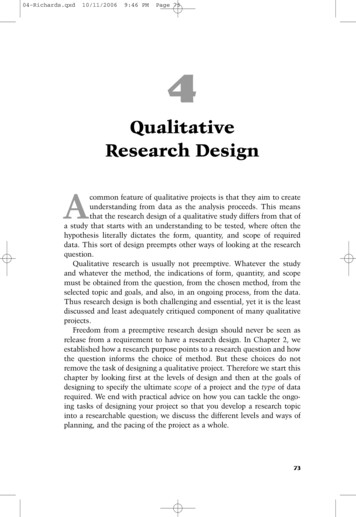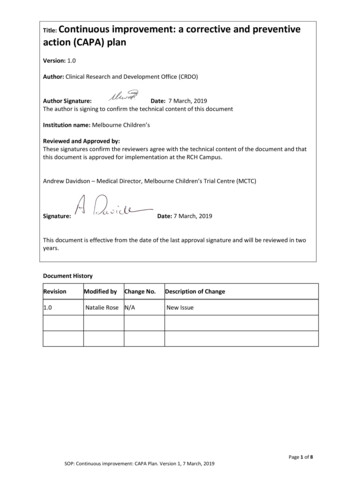
Transcription
Qualitative Researchfrom Start to Finish
Qualitative Researchfrom Start to Finish Robert K. YinTHE GUILFORD PRESSNew York London
To Karen and Andrew,for many years of love, devotion, and tolerance,and for being willing to entertain the possibility thatsocial science can be a lifelong and stimulating endeavor 2011 The Guilford PressA Division of Guilford Publications, Inc.72 Spring Street, New York, NY 10012www.guilford.comAll rights reservedNo part of this book may be reproduced, translated, stored in a retrievalsystem, or transmitted, in any form or by any means, electronic, mechanical,photocopying, microfilming, recording, or otherwise, without writtenpermission from the Publisher.Printed in the United States of AmericaThis book is printed on acid-free paper.Last digit is print number:987654 321Library of Congress Cataloging-in-Publication Data is availablefrom the Publisher.ISBN 978-1-60623-701-4 (pbk.)ISBN 978-1-60623-977-3 (hardcover)
PrefaceQualitative research has come of age. Published studies abound. Their findingscover nearly every worldly topic. Of equal importance, compelling methodological works now define the craft, placing it in the mainstream of social science. Yourinterest in qualitative research may reflect a desire to do it, teach it, or just learnabout it. In any of these situations, this book can help you.The Book A Practical ApproachAs its main theme, the book presents qualitative research from a practical perspective. Such a view reveals insights into how qualitative research is done, at theground level. The approach should be especially useful if in fact you are actuallywanting to conduct a qualitative study—whether it is to be self-standing, part of alarger study, or an academic or training assignment for an undergraduate, graduate, or continuing education course.An Inductive ApproachAlong the way, the book presents numerous examples of successfully completedand published qualitative studies, covering many different academic disciplinesand professions such as sociology, anthropology, psychology, education, publichealth, social work, community development, evaluation, and international affairs.The examples typically take the form of vignettes and quick studies, strewn through v
vi Prefaceout the book. Both provide more details about individual studies than the standard citations often found in other texts. Moreover, the studies come from widelyavailable journals and books. Their ready availability enables you to inspect thesematerials in greater detail, if you wish.Besides providing a more concrete foundation for understanding how qualitative research has been done by a broad variety of scholars, the numerous examples also convey the breadth of qualitative research. The topics extend over manydifferent types of social settings and everyday lives, while also covering the majorvariations in qualitative research, including action research, grounded theory, casestudies, feminist works, narrative inquiry, and phenomenology. As a most important characteristic, all of the illustrative studies are completed ones. As such, theyshould boost your confidence in being able to finish (and publish) your own qualitative research.Similarly, two completed studies, and how they were conducted in relation tothe material in Chapters 8, 9, and 12, are presented in depth at the end of thosechapters. The studies examine two topics (K–12 in one case and university administration in the other) intended to appeal to all readers because everyone has experienced the two environments.An Adaptive ApproachThe book deliberately presents qualitative research in an adaptive fashion, whichactually befits the craft. Rather than conveying it in a dogmatic, much less ideological manner, the book presents critical methodological topics—such as howto design or analyze qualitative research—in the form of optional choices. Thesechoices will enable you to customize your own study.For instance, you can create your own design, based on the eight choices presented in Chapter 4. The result can be a qualitative study that will range from theold-fashioned way of doing qualitative research to a more pragmatic approach thattakes advantage of current techniques and tools. Similarly, you have the choice ofstarting fieldwork before finalizing your research questions—an option examinedin Chapter 3. You also can decide whether or not to code your data, and whetheror not to use computer software to assist in analyzing your data, as discussed inChapters 8 and 9. If you have trouble starting a qualitative study in the first place,the ideas in Chapter 3 about creating a “study bank” offer insightful options.The Author My own experiences probably account for the book’s three preceding features—itspractical theme, devotion to understanding how other studies have been done, andneed for being adaptive. The practical guidance and inductive orientation comefrom having done over 30 years of social science research. During this time, I havedirectly overseen, led, or participated in nearly 200 studies—including those that
Preface viideliberately mixed qualitative and nonqualitative methods. The adaptive orientation reflects the fact that the studies have covered a wide array of fields, such as primary, secondary, and postsecondary education; health promotion, HIV/AIDS prevention, and substance abuse prevention; neighborhood, community, and urbandevelopment; crime prevention; technological innovation and diffusion; communications; and organizational development and program evaluation.All of the studies came to a formal written conclusion, either as an academicpublication or as a final report of some sort. Successfully arriving at such a concluding step means that I have practiced the entire research cycle many times—fromstart to finish. Each study started with an intensive scan and review of other comparable studies, which exposed me to the ways in which other scholars have designedand conducted their research. Because each of my own studies was done under different circumstances and addressed different research questions, I became exposedto the diverse ways in which studies can be designed, analyzed, and presented.Only in retrospect have I realized that these career experiences, along withresearch questions that inevitably address “how and why” questions, have includedan extensive amount of work with qualitative methods. Although I have not spentlong periods of time doing ethnography in the field, I have directed or conductednumerous field-based studies using participant-observation, case studies, qualitative interviews, field photography, and site visits. I have then had to struggle withthe options for analyzing the resulting data, drawing conclusions from them, andpresenting the studies before expert advisory panels or otherwise responding topeer reviews.The career experiences underlie my attempt to have this book cover qualitative research comprehensively. The various chapters address virtually every phaseof doing qualitative research, including some topics that also tend to be overlookedby other texts. For instance, nearly every qualitative study calls for presenting themeaning of social reality from the perspective of a study’s participants (peoplewhose lives are a large part of the subject of study). Yet, there are different waysof presenting their words or life histories, and this book explicitly addresses thesevariations (see Chapter 10). As another example, most books do not discuss the various ways of drawing conclusions from qualitative research, but this book identifiesat least five such ways (see Chapter 9). Finally, contemporary qualitative researchcan come from brief site visits to the field that are different from the traditionalethnographic stints, and this book describes the basic site visit procedures (seeChapter 5).The Organization of the BookThe Sequence of ChaptersBecause books have to be presented in linear fashion, they follow a particularsequence of chapters. However, as with all of qualitative research, nothing is linear. Understanding specific topics depends on being knowledgeable about other
viii Prefacetopics that a book might not yet have presented. In a way, a reader needs to knoweverything at once and then to revisit specific topics recursively. As a result, readers should feel free to tamper with the sequence of chapters in the book. Readerswanting to get started with a qualitative study can jump right into the book andstart at Chapter 3 or even Chapter 4. Conversely, readers wanting to understandthe deeper issues in doing qualitative research might want to read Chapters 1 and2 first. I personally wanted in my early days to understand the evidentiary basis forqualitative research, so I would have started by trying to understand the fieldworkand data collection activities in Chapters 5 and 6. You can see that the possiblesequences are nearly endless.Working FeaturesTo stimulate a reader’s active involvement with the book, the book has some additional features. First, the chapters all start with a brief abstract, overviewing thecontents of each chapter. Then, the sections within each chapter all start with apreview box, briefly covering what you should learn from this section. Finally, everychapter ends with a recap of the terms and concepts presented in the chapter.Second, each chapter also ends with an exercise reflecting the practices covered by the chapter. The exercises are intended to serve as out-of-class assignmentsthat can be done on a weekly basis. As an alternative, the Appendix contains acomprehensive, semester- or year-long project that can be done in lieu of (or evenin addition to) the individual exercises.Third, to save you a little bit of trouble, the book includes a brief glossary ofspecial terms used in qualitative research. Also at the back of the book, the editors at The Guilford Press permitted one discretionary stretching of the standardAmerican Psychological Association format: The reference section includes theauthors’ first names, not just their initials. Contextually, knowing the first namesclearly reduces confusion among persons who might have the same surname aswell as similar initials. Such knowledge also might help readers to connect the citedauthors with real-life people—who might even be teaching or have taught at one ofyour academic departments.As a final goal, the book also introduces you to a variety of methodologicalworks, whether dealing with issues of research ethics (Chapter 2), research design(Chapter 4), handling peer reviewers’ comments (Chapter 11), or engaging inmixed methods studies (Chapter 12). In covering these and related topics, I havetried to create a scholarly mix of citations to classical as well as contemporary works.Likewise, the relevant concepts range from understanding the value of “thickdescription” to challenging the rationale for the “gold standard.” At the same time,books such as the present one do not replace research readings. Textbooks cannotreproduce the rich spirit of a research field or its deeper meanings. Instead, goodtexts should provide two things: practical knowledge so you can pursue research,and clues in the form of citations where you can learn more about the spirit of afield. So it is with the present text.
AcknowledgmentsMy 30-year span of research experience covers work done at several differentresearch and academic organizations. Within each have been key colleagues whohave contributed to my understanding of the breadth of social science research,including qualitative research.At MIT, I studied under Professor Hans-Lukas Teuber. Together, we focusedon the topic of face recognition. Although the research used methods from experimental psychology, the topic—how people easily recognize and discriminate anextremely large number of faces despite their similarity according to any objectivemeasure—still in my mind represents a qualitative question of the first order.Later at MIT, but now in the Department of Urban Studies and Planning, Ialso had the pleasure of knowing Lawrence Susskind and Lloyd Rodwin, both ofwhom strongly encouraged my work on neighborhood development. That topicattracted a variety of research methods, ranging from the anthropological to thedemographic.Work at the New York City–Rand Institute and at the Rand Corporation’s officein Washington, DC, pushed me further into the investigation of urban as well asrelated policy topics. Peter Szanton made his mark on my thinking, through hisincessant questioning and sage advice on how to examine these topics. Similarly,a stint at American University’s School of International Service, guided by Professor Nanette Levinson, led to a broader array of research on international development.Through these years, the greatest effort has nevertheless been associated withmy affiliation with COSMOS Corporation—an independent research organizationdevoted to the examination of a wide variety of federal and state policy issues.COSMOS’s numerous clients, especially Bernice Anderson at the National Science ix
x AcknowledgmentsFoundation, have their own academic credentials and published work and createdtheir own brand of stimulating ideas and critical feedback. The key topics of discussion, if not contention, always tended to be methodological ones.Over the same years, I have gained a broader perspective through collaborativeteaching with scholars overseas, particularly in Denmark, France, and The Netherlands. For instance, a recent assignment involves working with doctoral studentsbeing led by Professor Iben Nathan at the University of Copenhagen.Most recently, I have spent a significant amount of time collaborating withscholars doing evaluation research at the United Nations. Together, we have had todevelop rigorous but cost-conscious ways of doing qualitative research on a broadvariety of international topics. At the United Nations, Sukai Prom-Jackson and Fabrizio Felloni have been primary collaborators and have sensitized me to the varietyof challenges involved in doing such research.The preparation of this book has benefited from a more immediate set ofcritical friends. They include seven reviewers of an earlier draft: Jessie L. Kreinert, Criminal Justice, Illinois State University (Normal); Penny Burge, Education,Virginia Tech; James A. Holstein, Social and Cultural Sciences, Marquette University; Michelle Bligh, School of Behavioral and Organizational Sciences, ClaremontGraduate University; Lance Fusarelli, Education Leadership, North Carolina StateUniversity; Thalia Mulvihill, Education, Ball State University; and Susan Shepler,School of Business, American University. You reviewers all kindly offered helpfulsuggestions and criticisms, even helping to re-sequence and restructure chaptersas well as identifying gaps that could be filled, and for this effort I will be forevergrateful.Numerous words of encouragement and advice came from a distinguishedcritical friend, C. Deborah Laughton, Guilford’s Publisher, Methodology and Statistics, whose experience in publishing qualitative and other research methodstexts probably goes farther back than she would want to acknowledge. Our longstanding acquaintance served as an invaluable presence in providing inspiration tostart (and complete) this book.Finally, my wife, Karen, and son, Andrew, had to tolerate the book’s continued distraction to our family life, over a lengthy period of time. They gave theirunconditional love, interspersed with compositional creativity in helping find better words and sharper sentences. The dedication of this book to them is but a smallway of acknowledging their enduring support.All of these interactions notwithstanding, none of the named institutions orindividuals bears any responsibility for the final product or for the statements inthis book.
ContentsPrefacevAcknowledgmentsixP a r t I . Understanding Qualitative ResearchChapter 1.What Is Qualitative Research—and Why Might You ConsiderDoing Such Research?3A. The Allure of Qualitative Research: A Topical Panoramaof Studies 3Vignette 1.1. A Qualitative Study of Homeless Women4B. The Distinctiveness of Qualitative Research 7Qualitative Research: A Broad Area of Inquiry 7Five Features of Qualitative Research 7VIGNETTE 1.2. Using Qualitative Research to Produce New Insights 9VIGNETTE 1.3. Using an Overarching Concept to Organize a Qualitative StudyCommon Practices 10C. The Multifaceted World of Qualitative ResearchMultiple Interpretations of the Same Events? 11VIGNETTE 1.4. An Immersion Study of Physicians' Training101114The Uniqueness of Human Events? 14Whether to Emulate One of Qualitative Research’s Variants 15Mediating Strategies 18D. Building Trustworthiness and Credibilityinto Qualitative Research 19Transparency 19Methodic-ness 19Adherence to Evidence 20Illustrative Studies Offered by the Remainder of This Book 21VIGNETTE 1.5. Qualitative Research Addressing a Major U.S. Policy ShiftVIGNETTE 1.6. Fifteen Years of Ethnography in the Ticuanense Community 2223xi
xii ContentsChapter 2.Equipping Yourself to Do Qualitative ResearchA. Competencies in Doing Qualitative Research“Listening” 26Asking Good Questions 27Knowing about Your Topic of Study 28Caring about Your Data 29Doing Parallel Tasks 29Persevering 30B. Managing Field-Based Research 312526VIGNETTE 2.1. Overcoming the Challenges of Doing Intensive,Field-Based Research 31VIGNETTE 2.2. A Qualitative Study Based Solely on Open-Ended Interviews 32Making Time to Think Ahead32VIGNETTE 2.3. Desirable Teamwork for a StudyBased on Open-Ended Interviews 34Managing as Part of a Field Team34VIGNETTE 2.4. Doing Fieldwork with Multiple Persons Workingin Multiple Settings 35VIGNETTE 2.5. Organizing a Research Team to Collect Extensive Field Data 36C. Practicing 36Using the Exercises in This Book to Practice 37Doing a Pilot Study 37Getting Motivated 37D. Setting and Maintaining Ethical Standards of Conduct 38An Illustrative Ethical Challenge: Fairly Examining Allof Your Data 38Codes of Ethics 39Research Integrity 41Disclosure as One Way of Demonstrating Research Integrity 41VIGNETTE 2.6. Detailing the Methodological Choices and Personal Conditionsin Doing a Qualitative Study 42VIGNETTE 2.7. Doing Qualitative Research and Advocatinga Sociopolitical Cause 43E. Protecting Human Subjects: Obtaining Approvalfrom an Institutional Review Board 44Submitting Study Protocols for Review and Approval 45Specific Considerations in Protecting Human Subjects 46Preparing for IRB Review 46The Informed Consent Dialogue (in the Field) as an Opportunityfor Participants to Query You 47Chapter 3.How to Start a Research StudyThe Challenge of Starting a Qualitative Study 50Originality in Doing a Qualitative Study 50The Rest of This Chapter 51A. Starting a Qualitative Study by Considering Three FeaturesParallel Processing the Start-Up Process 52Ways of Getting Started 52Developing a Study Bank 52Results from Creating an Illustrative “Study Bank” 53Considering a Topic of Inquiry 544951
Contents Considering a Data Collection Method 56VIGNETTE 3.1. An Interview Study Leading to a Policy Agenda 57Considering a Source of Data (e.g., Identifying a Field Setting) 58VIGNETTE 3.2. A Qualitative Study with Elementary School Childrenas the Main Sources of Data 59Remembering Time and Resource Constraints 60B. Reviewing Research Literature 61Whether (or Not) to Conduct a Review 61Role of Literature Review in Starting a Study 62VIGNETTE 3.3. Defining a New Study’s Contribution in Relationto Existing Literature 63Brief Summary: Different Types of Literature Reviews 64Taking Notes about Existing Studies 64Downloading Materials from Websites 65C. Detailing a New Qualitative Study 65Starting a Bit of Fieldwork First 66Starting with Research Questions 67Examining Your Own Background Knowledge and Perceptionsin Relation to a New Study 69P a r t I I . Doing Qualitative ResearchChapter 4.Choices in Designing Qualitative Research Studies75Brief Definition of Research Designs 75Design Options 76Choice 1: Starting a Research Design at the Beginningof a Study (or Not) 77Choice 2: Taking Steps to Strengthen the Validityof a Study (or Not) 78What Validity Means When Doing Research 78VIGNETTE 4.1. Seven Strategies for Combating Threats to Validityin Qualitative Research 79Rival Explanations 80Triangulation 81Choice 3: Clarifying the Complexity of Data CollectionUnits (or Not) 82Nested Arrangements 82Relationship between the Level of the Data Collection Units and theMain Topic of a Study 83EXHIBIT 4.1. Topics and Two Levels of Data Collection Unitsin Illustrative Qualitative Studies 84Choice 4: Attending to Sampling (or Not) 87Purposive and Other Kinds of Sampling 88The Number of Data Collection Units to Be Included in a StudyBroader Level 89VIGNETTE 4.2. Studying Inequality in the Retail Marketplace90VIGNETTE 4.3. Six Ethnographic Accounts as Part of a Single StudyNarrower Level 91VIGNETTE 4.4. A Comparative, Four-Case Design across Time,within the Same Venue 919089xiii
xiv ContentsVIGNETTE 4.5. Seeking Multiple Data Collection Units,but in a Methodic Variety of Ways 92Choice 5: Incorporating Concepts and Theoriesinto a Study (or Not) 93Worlds Devoid of Concepts? 93Inductive versus Deductive Approaches 93VIGNETTE 4.6. How Fieldwork Can Lead to a Useful Typology94VIGNETTE 4.7. Studying a Preestablished Concept:Pedagogical Content Knowledge 95VIGNETTE 4.8. Studying Privatization within Former Soviet-Bloc Countries 96Choice 6: Planning at an Early Stage (or Not)to Obtain Participant Feedback 96Feedback Choices 97Potential Influence on a Study’s Later Narrative 97Choice 7: Being Concerned with Generalizinga Study’s Findings (or Not) 98Need for Reaching beyond Statistical GeneralizationsMaking Analytic Generalizations 9999VIGNETTE 4.9. Generalizing the Findings from a Single-Case Study100VIGNETTE 4.10. An Example of Analytic Generalizationfrom a Single Qualitative Study 101Choice 8: Preparing a Research Protocol (or Not)Protocols, Not Instruments 102Protocols as Mental Frameworks 103Operational Definitions 107Chapter 5.102Doing Fieldwork109A. Working in the Field 111Variety of Field Settings 111VIGNETTE 5.1. Examples of “Everyday” Settings 112Differing Rules and Expectations for Public or Private Placesas Field Settings 113Varying the Amount of Time in the Field 113B. Gaining and Maintaining Access to the Field 114Gaining Access to a Field Setting: A Process, Not an Event 114How the Process Can Influence the Substance of a Study 115VIGNETTE 5.2. Access Gained and Then Restricted115VIGNETTE 5.3. Questions of Continuation Raisedin the Third Year of Fieldwork 116VIGNETTE 5.4. Working as a Store Clerk116VIGNETTE 5.5. Residing and Working in a Transitioning Urban Neighborhood117C. Nurturing Field Relationships 118Portraying Your Authentic Self 118Importance of Personal Demeanor 119VIGNETTE 5.6. The Fieldworker in Action119Doing Favors for Participants: Part of the Relationship or Not?Coping with Unexpected Events 120Planning How to Exit, Not Just Enter, the Field 121120
Contents D. Doing Participant- Observation 121The Researcher as the “Research Instrument” 122VIGNETTE 5.7. Doing Fieldwork in Two Houses of Worship 123VIGNETTE 5.8. Racial and Ethnic Congruencies 124Taking an Inductive Stance Even If a Study Startedwith Some Propositions 124E. Making Site Visits 125Studying a Large Number of Field Settings 126Adhering to Formal Schedules and Plans 126Being “Hosted” during a Site Visit 127Building Teamwork 127Chapter 6.Data Collection Methods129A. What Are Data? 129B. Introduction to Four Types of Data Collection Activities130Exhibit 6.1. Data Collection Methods and Types of Datafor Qualitative Research 131C. Interviewing 132Structured Interviews 133VIGNETTE 6.1. Qualitative Interviewing as a Social Relationship 134Qualitative Interviews 134Doing Qualitative Interviews135VIGNETTE 6.2. Using “Grand Tour” Questions to Start Your Conversing137VIGNETTE 6.3. Nondirectively Interviewing Peopleabout the Key Topic of Study 138“Entering” and “Exiting” Qualitative Interviews 139Interviewing Groups of People 140Focus Group Interviewing as a Methodof Collecting Qualitative Data 141VIGNETTE 6.4. A Distinguished “Manual” for Collecting Focus Group Data 141VIGNETTE 6.5. Using Focus Groups as the Only Data from the “Field”142D. Observing 143Doing “Systematic Observation” as the Basisfor an Entire Qualitative Study 143VIGNETTE 6.6. Systematic Observations in School Classrooms 143VIGNETTE 6.7. “Observational Studies” Also Refer to Research Definedby Statistical Principles and Methods 144Deciding When and Where to Observe 144Deciding What to Observe 145VIGNETTE 6.8. “Unobtrusive Measures” as the Subject of Observations 146Taking Advantage of Unobtrusive Measures 146Deriving Meaning from Observations, and TriangulatingObservational Evidence with Other Sources 147E. Collecting and Examining 147VIGNETTE 6.9. Intertwining Historical and Field EvidenceCollecting Objects (e.g., Documents, Artifacts,and Archival Records) in the Field:Invaluable but Also Time- Consuming 148148xv
xvi ContentsUsing Documents to Complement Field Interviewsand Conversations 149“Surfing” and “Googling” for Related Information 149Collecting or Examining Objects as a Complementary Partof Your Data Collection 150F. Feelings 150“Feelings” Take Different Forms 150Documenting and Recording Feelings 151G. Desirable Practices Pertinent to All Modes of Data CollectionChapter 7.151Recording Data155A. What to Record 156Trying to Record “Everything” versus Being Too Selective 156Highlighting Actions and Capturing Words Verbatim 157VIGNETTE 7.1. Different Examples of “Vivid Images”158Remembering Your Research Questions 159Taking Notes about Written Studies, Reports, and DocumentsFound in the Field 159VIGNETTE 7.2. The Verbatim Principle159Duplicating Copies of Documents and Written MaterialsWhile in the Field 160B. Note- Taking Practices When Doing Fieldwork 161Being Prepared 161Setting Up Your Notes 161Developing Your Own Transcribing Language 162EXHIBIT 7.1. Sample of Field Notes 163Creating Drawings and Sketches as Part of the Notes 164Exhibit 7.2. Sketches in Field Notes 165C. Converting Field Notes into Fuller Notes 166Converting Field Notes Quickly 166Minimum Requirement for the Daily Conversionof the Original Field Notes 167Four Additional Ways of Enhancing the Original Field Notes 167Deepening Your Understanding of Your Fieldwork 168Verifying Field Notes 168Exhibit 7.3. Sample Items Needing Further Field Clarification,as Revealed during Nightly Review of Field Notes 169VIGNETTE 7.3. “Checking Stuff” 169Exhibit 7.4. Illustrative Types of Verifications between Different Sourcesof Field Evidence 170D. Recording Data through Modes Other Than Writing 171Obtaining Permission to Record 171Mastering Recording Devices before Using Them 172Sharing the Recordings and Maintaining Their Security 172Being Prepared to Spend Time Reviewing and Editingthe Recordings 173When Electronic Recordings Are the MainData Collection Technique 173Producing Finished Products 174E. Keeping a Personal Journal 175
Contents Chapter 8.Analyzing Qualitative Data, I: Compiling, Disassembling,and Reassembling176A. Overview of the Analytic Phases 177Introduction to a Five- Phased Cycle: (1) Compiling,(2) Disassembling, (3) Reassembling (and Arraying),(4) Interpreting, and (5) Concluding 177EXHIBIT 8.1. Five Phases of Analysis and Their Interactions 178Using Computer Software to Assist in AnalyzingQualitative Data 179VIGNETTE 8.1. A Helpful Guide for Using CAQDAS Software181B. Compiling an Orderly Set of Data 182Parallel to Quantitative Research? 182Rereading and Relistening: Getting to “Know” Your Field Notes 183Putting Everything into a Consistent Form 183Using Computer Software to Compile Your Records 184C. Disassembling Data 186Memo Writing 186To Code or Not to Code 186Coding Data 187VIGNETTE 8.2. Guidance for Coding Qualitative Data 187Disassembling Data without Coding Them 188Exhibit 8.2. Examples of Level 1 and Level 2 Coding189Using Computer Software to Assist in Disassembling Data 190D. Reassembling Data 190Looking for Patterns 190Using Arrays to Help Reassemble Data 191Creating Hierarchical Arrays 191Designing Matrices as Arrays 193VIGNETTE 8.3. Creating Matrices to Reassemble Qualitative Data 193VIGNETTE 8.4. Studying Neighborhood Change 194EXHIBIT 8.3. Illustrative Chronology Matrix 195Working with Other Types of Arrays 196Summarizing the Arraying Process 196Important Procedures during the Reassembling Process 196Using Computer Software to Assist in Reassembling Data 198Final Words on Reassembling 199Exhibit 8.4. Headings and Sample Glossary for a Single Recordin Sample Study 1 202Exhibit 8.5. Eight Activities Emerging from Review of Database,Then Used as Codes in Sample Study 1 203Chapter 9.Analyzing Qualitative Data, II: Interpreting and ConcludingEXHIBIT 9.1. Recursive Relationships Among Four Analytic Phases 206A. Interpreting 207B. Modes of Interpreting 208“Description” as a Major Type of Interpretation 209EXHIBIT 9.2. Description as Interpretation: Authors, Subtitles,and Chapter Headings of Illustrative Studies 211EXHIBIT 9.3. Description-plus-Call-for-Action as Interpretation: Authors,Subtitles, and Chapter Headings of Illustrative Studies 214205xvii
xviii ContentsDescription plus a Call for Action 214“Explanation” as a Type of Interpretation 216EXHIBIT 9.4. Explanation as Interpretation: Authors, Subtitles,and Chapter Headings of Illustrative Studies 217Creating Insightful and Usable Interpretations 219VIGNETTE 9.1. An Interpretive Theme That Appears throughouta Qualitative Study 220C. Concluding 220Concluding by Calling for New Research 221Concluding by Challenging Conventional Generalizationsand Social Stereotypes 221VIGNETTE 9.2. Conclusions That Challenge Conventional Generalizations 222Concluding with New Concepts, Theories, and Even “Discoveries”about Hu
Qualitative Research from start to finish . of doing qualitative research, including some topics that also tend to be overlooked by other texts. For instance, nearly every qualitative study calls for presenting the meaning of social reali










